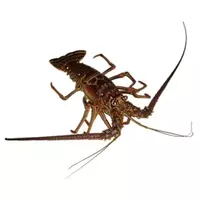Spiny lobster

Many people confuse langoustas with lobster (lobster), but despite the fact that both of them belong to the species of crustaceans, the former lacks claws. The adult lancet can reach a maximum size of 23 centimeters, while weighing up to four kilograms. These inhabitants of the deep sea are able to actively reproduce, but today their population is gradually decreasing. In addition, the extraction of langoustes on a large scale is often hampered by the fact that they grow for a very long time. Being one of the most popular marine delicacies, langouste dishes are constantly on the menus of five-star restaurants in Bali, Thailand, the Caribbean islands, as well as the Bahamas.
The cooked langouche is considered a special delicacy when it is still alive, so when transported, fresh crustaceans are placed in moist wood chips. Until the time of sale, they are usually kept in aquariums. It is possible to check whether the lancet is actually of excellent quality by the "poke method, " that is, if you raise it, it will definitely hit the tail. At the same time, pay attention to the fact that the tail of the langouste is twisted inward. All legs of sea cancer should be whole, and there should be no holes in the shell. Antennae are almost inevitably damaged during transportation, but this is not very important. It is not difficult to distinguish a female from a male: a female can be recognized by the handbag in which they throw caviar, and they are larger in size.
For cooking, only the tail (chefs call this part "neck") and the abdomen of the langouste are suitable. This is not so little as it seems at first glance, because large individuals in the neck contain about 1 kg of first-class tender meat. In our stores, for example, you can find langoustas in frozen form, precisely as its tail part.
Langoustas can be baked, simmered, fried, boiled, as well as added to salads, soups and other complex dishes. You can say that they cook them in much the same way as lobsters, but the taste of langouste meat is much more delicate.
Catalan makes langouste in Spain, adding unsweetened chocolate and tomato sauce to it, seasoning it with grated hazelnuts and almonds, cinnamon and pepper. The Chinese version is a langust with the addition of ginger, onions, sesame oil and incisor onions. In France, a country known for its culinary delights, langoustas are often used to prepare expensive and at the same time unusual dishes. So, for example, this marine crustacean is flambered using cognac.
langousta 88 kCal
Energy value of langouste (Ratio of proteins, fats, carbohydrates - ju):
Proteins: 17.5 (~ 70 kCal)
Fats: 2g (~ 18kCal)
Carbohydrates: 0 g (~ 0 kCal)
Energy ratio (b | y): 80% | 20% | 0%
 Español
Español Français
Français Português
Português Русский
Русский 简体中文
简体中文 繁體中文
繁體中文 日本語
日本語 한국어
한국어 العربية
العربية Türkçe
Türkçe Қазақ
Қазақ Deutsch
Deutsch Italiano
Italiano Українська
Українська
